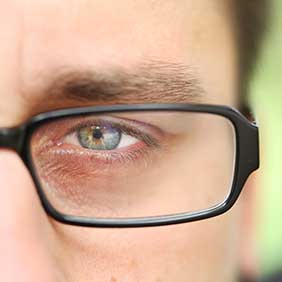 By Laura O’Donnell
By Laura O’Donnell
Eye fatigue, stinging eyes, that persistent feeling of something being caught under your eyelid, even blurred vision. . . these all can be signs of dry eye. To someone who’s never had to deal with it, it doesn’t sound like a terrible condition, but to those who suffer through the stinging, burning, and constant irritation, it’s a daily trial affecting one of their most important senses.
Most of us need to be able to see properly to drive or to work. Even most forms of entertainment today require the ability to see. It’s all made more difficult when your vision or your ability to keep your eyes open is compromised by dry eye.
Dry eye occurs when the eye does not produce tears in the proper amount, either because there aren’t enough or because the tears are lacking certain components and they evaporate before they have the chance to properly lubricate the eye. The dryness can cause the surface of the eye to become inflamed, eventually leading to scars on the cornea or ulcers. While this can cause a partial loss of vision, such losses are rarely permanent when it comes to dry eye.
Causes of Dry Eye
Dry eye has many causes, some of them only causing the condition temporarily, while others can make it a long term problem. These causes can include:
● Pregnancy
● Allergies
● Infrequent blinking, such as when looking at a video screen or monitor for long periods of time.
● Hormone replacement therapy can often cause dry eye, especially with women who only take estrogen; women who take both estrogen and progesterone have a much lower risk of developing dry eye.
● Certain medications, including birth control pills, antidepressants, certain antihistamines, tranquilizers, and nasal decongestants.
● Chronic inflammation of certain parts of the eye, caused by various eye diseases, infection, or exposure to irritants like chemical fumes and tobacco smoke.
● If you have LASIK surgery done, you may notice after the procedure some symptoms associated with dry eye.
These are not the only causes of dry eye, but the wide range of just the few causes listed shows that many, many people will probably have to deal with dry eye at some point in their lives.
Types of Dry Eye
Doctors recognize two types of dry eye: aqueous tear-deficient dry eye and evaporative dry eye.
Aqueous tear-deficient dry eye occurs when the lacrimal glands, which produce tears, do not produce enough liquid to protect the surface of the eye.
Evaporative dry eye is often caused by the inflammation of the meibomian glands, which can be found in the eyelids. These provide an oily component to tears that prevents them from evaporating too rapidly. When these glands are not working correctly, the tears evaporate too quickly to be of any use.
How to Treat Dry Eye
There are things you can do for yourself, without ever seeing a doctor, if you are suffering from dry eye. There are all manner of over-the-counter remedies, like artificial tears or certain ointments that can offer relief. If you need to use such materials more than four times a day, avoid using artificial tears with preservatives.
Wrap-around sunglasses or glasses not only make your tears evaporate more slowly, they can help prevent irritants from getting into the eyes.
Simply resting your eyes can make all the difference, especially if your work involves looking at a computer screen or reading for long periods of time. While eye drops can help to lubricate your eyes, often all that’s needed is to rest your eyes for some time. Taking short breaks every so often may be all you need to solve your dry eye problem.
Not all cases of dry eye can be self-treated, unfortunately. Your doctor has a number of different solutions that can help those of you suffering from a more chronic form of dry eye.
For instance, you may be prescribed the drops known as Restasis. These drops not only lubricate the eye, just like OTC drops, but they can reduce the inflammation in your eyes, which helps you produce tears naturally. The effects of Restasis, however, are not instant. It generally takes at least 90 days for a patient to fully feel the benefits. Some who take it might even feel burning eyes during the first few days of treatment.
Steroid eye drops are a short-term solution, generally used in combination with conventional eye drops and/or Restasis. These help to rapidly reduce inflammation in the eye. Doctors who use steroid eye drops generally start with a very mild version which is quickly absorbed by the eye, reserving more potent drops for more extreme symptoms and situations.
Clogged meibomian glands can sometimes be opened up by applying a warm compress to the eyes. Using this, your doctor can cause hardened glands to soften up so they do their work of keeping your eyes lubricated. The downside is that these compresses have to be fairly hot (108 degrees Fahrenheit) and maintain that temperature for the entire ten minutes needed for the treatment. Also, this method generally needs to be used at least twice a day. Needless to say, it’s difficult for some patients to maintain this treatment themselves for extended periods.
There are other, more elaborate means of caring for dry eye symptoms, but one of the easiest may still be to take care of your eyes by taking care of the rest of your body. Eat foods containing omega-3 fatty acids, like cold water fish, and drink lots of water to make sure dehydration does not contribute to your dry eye symptoms. Blink and keep your eyes well-rested, especially during vision-intensive work. Just these little helpful actions can go a long way toward relieving your dry eye symptoms.












